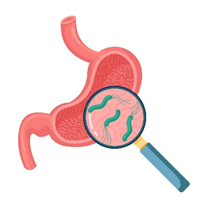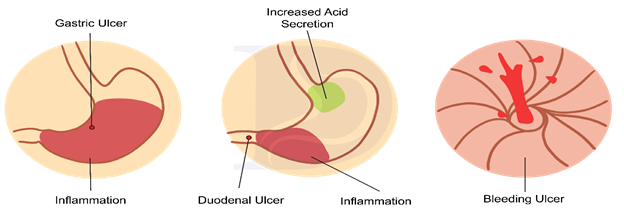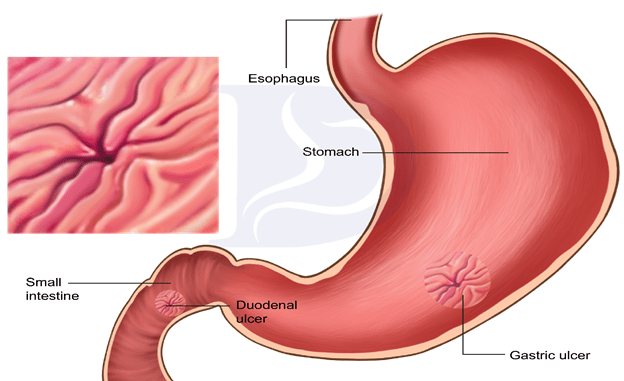Helicobacter pylori (H. pylori) is a bacteria associated with digestive illnesses, including gastritis, gastric ulcers, and chronic infection cancer. H. pylori infection is common and present in two-thirds of the total population worldwide.1 H. pylori infection is usually harmless, but it may lead to stomach and small intestine ulcers if left untreated.
Helicobacter pylori is a spiral-shaped bacteria that can change the lower pH of the stomach, which helps it survive for a longer time. After residing in the stomach, it may cross through the stomach lining where it can survive in immune cells.2
Causes of Helicobacter pylori infection:
The exact cause of H. pylori infection is still unknown. However, it may spread through direct contact such as:
- Mouth-to-mouth contact, e.g., kissing
- Stool
- Vomit or bodily fluids
- Contaminated water and food
- Not washing hands after using the toilet

Risk Factors associated with H. pylori infection:
Age
Children are more likely to get H. pylori infection because children are less likely to follow hygienic measures.
Environment
Living in an underdeveloped country where access to clean water is rare may increase the chances of acquiring an infection from H. pylori. Overcrowding and dense populations of people in a local area can also affect the likelihood of spreading the bacteria.
Symptoms
Signs and symptoms of H. pylori infection may vary depending upon the severity and duration of infection.3
- Burning sensation and pain in the belly
- Feeling of an empty stomach that goes away with drinking water and eating food
- Unexplained weight loss
- Poor appetite
- Nausea
- Blood in stool
- Weakness and fatigue
Complications
Chronic H. pylori infection can lead to conditions such as gastritis, dyspepsia, stomach and duodenal ulcers, cancer, and lymphoma.
Gastritis and dyspepsia
- pylori symptoms can include bloating, vomiting, and diarrhea. However, these symptoms are not specific to only this infection. Proper diagnosis through X-ray is required to confirm the presence of ulcers and to verify the type of infection.
Ulcers
H. pylori is found in 60–80% of cases in which patients suffer from stomach ulcers. Ulcers will rupture the stomach lining, allowing the stomach acid to seep through the walls, and further rupture stomach cells. Research shows that more than 80% of duodenal ulcer patients have H. pylori infection.
Stomach cancer
Although not all H. pylori infections lead to cancer, two types of cancer, including gastric cancer, are associated with H. pylori infections. Chronic infection from childhood may also lead to cancer.
Diagnosis of H. pylori Infection
Apart from history and symptoms, the following tools can be applied for diagnosing H. pylori infection:
Blood test
A blood sample can be collected for a laboratory test to diagnose the antibodies against H. pylori.
Stool test
For this test, a stool sample is collected and a laboratory test is performed to confirm the presence of antigen or H. pylori bacteria.
Breath test
Another diagnostic method is measuring the level of carbon dioxide in exhaled breath. Carbon dioxide levels in the breath may increase due to H. pylori infection.
Endoscopy
A thin, light tube is inserted into the esophagus to visually explore the presence of ulcers and infected areas of the stomach and small intestines.4
Treatment
Initially, there is no need for treatment if there aren’t any symptoms.
H2 blockers: Certain medicines, which are available over the counter, are capable of decreasing acid production from the stomach. Decreased acid production may stop further underlying cellular damage.
Antibiotics: Clarithromycin, amoxicillin, bismuth subsalicylate, and metronidazole are used to lessen a H. pylori infection. Antibiotics are necessary to fully clear the infection.
Lifestyle changes: It is essential to adopt a healthy lifestyle and ensure hygiene to recover from infection.5
Summary
Helicobacter pylori is a common bacterial infection of the stomach. Although it begins as a mild condition, it may lead to gastritis, ulcers, and even cancer. Several diagnostic tests and treatments are available to avoid the reoccurrence of ulcers and reduce the chances of cancer.
References
- Zamani M, Ebrahimtabar F, Zamani V, et al. Systematic review with meta-analysis: the worldwide prevalence of Helicobacter pylori infection. Aliment Pharmacol Ther. 2018;47(7):868-876. doi:10.1111/APT.14561
- Goderska K, Agudo Pena S, Alarcon T. Helicobacter pylori treatment: antibiotics or probiotics. Appl Microbiol Biotechnol. 2018;102(1):1. doi:10.1007/S00253-017-8535-7
- Kusters JG, Van Vliet AHM, Kuipers EJ. Pathogenesis of Helicobacter pylori Infection. Clin Microbiol Rev. 2006;19(3):449. doi:10.1128/CMR.00054-05
- Fischbach W, Malfertheiner P. Helicobacter Pylori Infection: When to Eradicate, How to Diagnose and Treat. Dtsch Arztebl Int. 2018;115(25):429. doi:10.3238/ARZTEBL.2018.0429
- Parikh NS, Ahlawat R. Helicobacter Pylori. StatPearls. Published online August 11, 2021. Accessed May 24, 2022. https://www.ncbi.nlm.nih.gov/books/NBK534233/




